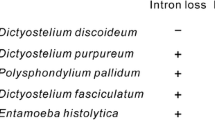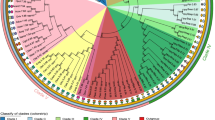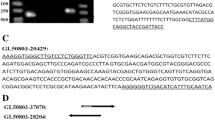Abstract
Although intron loss and gain have been widely observed, their mechanisms are still to be determined. In four Aspergillus genomes, we found 204 cases of intron loss and 84 cases of intron gain. Using this data, we tested common hypotheses of intron loss or gain. Statistical analysis showed that adjacent introns tend to be lost simultaneously and small introns were preferentially lost, supporting the model of mRNA-mediated intron loss. The lost introns reside in internal regions of genes, which is inconsistent with the traditional version of the model (partial length cDNAs are reverse transcribed from 3′ ends of mRNAs), but consistent with an alternate version (partial length cDNAs are produced by self-primed reverse transcription). The latter version was not supported by examination of the abundance of T-rich segments in mRNAs. Preferential loss of internal introns might be explained by highly efficient recombination at internal regions of genes. Among the 84 cases of intron gain, we found a significantly higher frequency of short direct repeats near exon–intron boundary than in conserved introns, supporting the double-strand break repair model. We also found possible source sequences for two cases of intron gain, one by gene conversion and one by insertion of a mitochondrial sequence during double-strand break repair. Source sequences for most gained introns could not be identified and the possible reasons were discussed. In the four Aspergillus genomes studied, we did not find evidence of frequent parallel intron gains.




Similar content being viewed by others
References
Ahmadinejad N, Dagan T, Gruenheit N, Martin W, Gabaldon T (2010) Evolution of spliceosomal introns following endosymbiotic gene transfer. BMC Evol Biol 10:57
Basu MK, Rogozin IB, Deusch O, Dagan T, Martin W, Koonin EV (2008) Evolutionary dynamics of introns in plastid-derived genes in plants: saturation nearly reached but slow intron gain continues. Mol Biol Evol 25:111–119
Carmel L, Wolf YI, Rogozin IB, Koonin EV (2007) Three distinct modes of intron dynamics in the evolution of eukaryotes. Genome Res 17:1034–1044
Catania F, Lynch M (2008) Where do introns come from? PLoS Biol 6:e283
Catania F, Gao X, Scofield DG (2009) Endogenous mechanisms for the origins of spliceosomal introns. J Hered 100:591–596
Coulombe-Huntington J, Majewski J (2007a) Characterization of intron loss events in mammals. Genome Res 17:23–32
Coulombe-Huntington J, Majewski J (2007b) Intron loss and gain in Drosophila. Mol Biol Evol 24:2842–2850
de Souza SJ (2003) The emergence of a synthetic theory of intron evolution. Genetica 118:117–121
Derr LK, Strathern JN, Garfinkel DJ (1991) RNA-mediated recombination in S. cerevisiae. Cell 67:355–364
Eickbush TH, Furano AV (2002) Fruit flies and humans respond differently to retrotransposons. Curr Opin Genet Dev 12:669
Farlow A, Meduri E, Dolezal M, Hua L, Schlotterer C (2010) Nonsense-mediated decay enables intron gain in Drosophila. PLoS Genet 6:e1000819
Feiber AL, Rangarajan J, Vaughn JC (2002) The evolution of single-copy Drosophila nuclear 4f-rnp genes: Spliceosomal intron losses create polymorphic alleles. J Mol Evol 55:401–413
Fink GR (1987) Pseudogenes in yeast? Cell 49:5–6
Gao X, Lynch M (2009) Ubiquitous internal gene duplication and intron creation in eukaryotes. Proc Natl Acad Sci USA 49:20818–20823
Hankeln T, Friedl H, Ebersberger I, Martin J, Schmidt ER (1997) A variable intron distribution in globin genes of Chironomus: evidence for recent intron gain. Gene 205:151–160
Hoskins RA, Carlson JW, Kennedy C, Acevedo D, Evans-Holm M, Frise E, Wan KH, Park S, Mendez-Lago M, Rossi F, Villasante A, Dimitri P, Karpen GH, Celniker SE (2007) Sequence finishing and mapping of Drosophila melanogaster heterochromatin. Science 316:1625–1628
Huppert JL (2008) Thermodynamic prediction of RNA-DNA duplex-forming regions in the human genome. Mol Biosyst 4:686–691
Irimia M, Rukov JL, Penny D, Vinther J, Garcia-Fernandez J, Roy SW (2008) Origin of introns by ‘intronization’ of exonic sequences. Trends Genet 24:378–381
Jeffares DC, Mourier T, Penny D (2006) The biology of intron gain and loss. Trends Genet 22:16–22
Jeffares DC, Penkett CJ, Bahler J (2008) Rapidly regulated genes are intron poor. Trends Genet 24:375–378
Knowles DG, McLysaght A (2006) High rate of recent intron gain and loss in simultaneously duplicated Arabidopsis genes. Mol Biol Evol 23:1548–1557
Lane CE, van den Heuvel K, Kozera C, Curtis BA, Parsons BJ, Bowman S, Archibald JM (2007) Nucleomorph genome of Hemiselmis andersenii reveals complete intron loss and compaction as a driver of protein structure and function. Proc Natl Acad Sci USA 104:19908–19913
Larkin MA, Blackshields G, Brown NP, Chenna R, McGettigan PA, McWilliam H, Valentin F, Wallace IM, Wilm A, Lopez R, Thompson JD, Gibson TJ, Higgins DG (2007) Clustal W and clustal X version 2.0. Bioinformatics 23:2947–2948
Lawson MJ, Jiao J, Fan WG, Zhang LQ (2009) A pattern analysis of gene conversion literature. Comp Funct Genom 2009:761512
Li W, Tucker AE, Sung W, Thomas WK, Lynch M (2009) Extensive, recent intron gains in Daphnia populations. Science 326:1260–1262
Lin H, Zhu W, Silva J, Gu X, Buell CR (2006) Intron gain and loss in segmentally duplicated genes in rice. Genome Biol 7:R41
Llopart A, Comeron JM, Brunet FG, Lachaise D, Long M (2002) Intron presence-absence polymorphism in Drosophila driven by positive Darwinian selection. Proc Natl Acad Sci USA 99:8121–8126
Loh Y-H, Brenner S, Venkatesh B (2008) Investigation of loss and gain of introns in the compact genomes of Pufferfishes (Fugu and Tetraodon). Mol Biol Evol 25:526–535
Long M, Rosenberg C, Gilbert W (1995) Intron phase correlations and the evolution of the intron/exon structure of genes. Proc Natl Acad Sci USA 92:12495–12499
Mak J, Kleiman L (1997) Primer tRNAs for reverse transcription. J Virol 71:8087–8095
Morrison HG, McArthur AG, Gillin FD, Aley SB, Adam RD, Olsen GJ, Best AA, Cande WZ, Chen F, Cipriano MJ, Davids BJ, Dawson SC, Elmendorf HG, Hehl AB, Holder ME, Huse SM, Kim UU, Lasek-Nesselquist E, Manning G, Nigam A, Nixon JEJ, Palm D, Passamaneck NE, Prabhu A, Reich CI, Reiner DS, Samuelson J, Svard SG, Sogin ML (2007) Genomic minimalism in the early diverging intestinal parasite Giardia lamblia. Science 317:1921–1926
Mourier T, Jeffares DC (2003) Eukaryotic intron loss. Science 300:1393
Nielsen CB, Friedman B, Birren B, Burge CB, Galagan JE (2004) Patterns of intron gain and loss in fungi. PLoS Biol 2:e422
Niu D-K (2007) Protecting exons from deleterious R-loops: a potential advantage of having introns. Biol Direct 2:11
Niu D-K, Hou W-R, Li S-W (2005) mRNA-mediated intron losses: evidence from extraordinarily large exons. Mol Biol Evol 22:1475–1481
Paigen K, Petkov P (2010) Mammalian recombination hot spots: properties, control and evolution. Nat Rev Genet 11:221–233
Plohl M, Luchetti A, Mestrovic N, Mantovani B (2008) Satellite DNAs between selfishness and functionality: structure, genomics and evolution of tandem repeats in centromeric (hetero)chromatin. Gene 409:72–82
Putnam NH, Srivastava M, Hellsten U, Dirks B, Chapman J, Salamov A, Terry A, Shapiro H, Lindquist E, Kapitonov VV, Jurka J, Genikhovich G, Grigoriev IV, Lucas SM, Steele RE, Finnerty JR, Technau U, Martindale MQ, Rokhsar DS (2007) Sea anemone genome reveals ancestral eumetazoan gene repertoire and genomic organization. Science 317:86–94
Rodriguez-Trelles F, Tarro R, Ayala FJ (2006) Origins and evolution of spliceosomal introns. Annu Rev Genet 40:47–76
Roy SW (2004) The origin of recent introns: transposons? Genome Biol 5:251
Roy SW (2009) Intronization, de-intronization and intron sliding are rare in Cryptococcus. BMC Evol Biol 9:192
Roy SW, Gilbert W (2005a) The pattern of intron loss. Proc Natl Acad Sci USA 102:713–718
Roy SW, Gilbert W (2005b) Rates of intron loss and gain: implications for early eukaryotic evolution. Proc Natl Acad Sci USA 102:5773–5778
Roy SW, Gilbert W (2006) The evolution of spliceosomal introns: patterns, puzzles and progress. Nat Rev Genet 7:211–221
Roy SW, Hartl DL (2006) Very little intron loss/gain in Plasmodium: intron loss/gain mutation rates and intron number. Genome Res 16:750–756
Roy SW, Irimia M (2009) Mystery of intron gain: new data and new models. Trends Genet 25:67–73
Roy SW, Penny D (2006a) Large-scale intron conservation and order-of-magnitude variation in intron loss/gain rates in apicomplexan evolution. Genome Res 16:1270–1275
Roy SW, Penny D (2006b) Smoke without fire: most reported cases of intron gain in Nematodes instead reflect intron losses. Mol Biol Evol 23:2259–2262
Roy SW, Penny D (2007) Patterns of intron loss and gain in plants: intron loss-dominated evolution and genome-wide comparison of O. sativa and A. thaliana. Mol Biol Evol 24:171–181
Roy SW, Irimia M, Penny D (2006) Very little intron gain in Entamoeba histolytica genes laterally transferred from prokaryotes. Mol Biol Evol 23:1824–1827
Scherer S (2008) A short guide to the human genome. Cold Spring Harbor Laboratory Press, New York
Sharpton TJ, Neafsey DE, Galagan JE, Taylor JW (2008) Mechanisms of intron gain and loss in Cryptococcus. Genome Biol 9:R24
Stajich JE, Dietrich FS (2006) Evidence of mRNA-mediated intron loss in the human-pathogenic fungus Cryptococcus neoformans. Eukaryot Cell 5:789–793
Stajich JE, Dietrich FS, Roy SW (2007) Comparative genomic analysis of fungal genomes reveals intron-rich ancestors. Genome Biol 8:R223
Szekvolgyi L, Nicolas A (2010) From meiosis to postmeiotic events: homologous recombination is obligatory but flexible. FEBS J 277:571–589
Volff JN, Bouneau L, Ozouf-Costaz C, Fischer C (2003) Diversity of retrotransposable elements in compact pufferfish genomes. Trends Genet 19:674–678
Wilkerson MD, Ru Y, Brendel VP (2009) Common introns within orthologous genes: software and application to plants. Brief. Bioinform 10:631–644
Williams RL (1975) The shoot apex and leaf growth. Cambridge University Press, London
Acknowledgments
We thank the anonymous reviewers for helpful comments and Jian-Li Cao for his kind help. This work was supported by the Fundamental Research Funds for the Central Universities (2009SAP-4) and the Program for New Century Excellent Talents in University (NCET-07-0094).
Author information
Authors and Affiliations
Corresponding author
Electronic Supplementary Material
Below is the link to the electronic supplementary material.
Rights and permissions
About this article
Cite this article
Zhang, LY., Yang, YF. & Niu, DK. Evaluation of Models of the Mechanisms Underlying Intron Loss and Gain in Aspergillus Fungi. J Mol Evol 71, 364–373 (2010). https://doi.org/10.1007/s00239-010-9391-6
Received:
Accepted:
Published:
Issue Date:
DOI: https://doi.org/10.1007/s00239-010-9391-6




